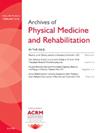黑人创伤性脑损伤后10年的整体功能轨迹:一项模型系统研究。
IF 3.7
2区 医学
Q1 REHABILITATION
Archives of physical medicine and rehabilitation
Pub Date : 2025-09-01
DOI:10.1016/j.apmr.2025.03.034
引用次数: 0
摘要
目的:本研究考察了:(a)一组黑人创伤性脑损伤(TBI)后10年的纵向整体功能轨迹,以及(b)这些轨迹的人口统计学和损伤相关预测因子。设计:参与者在TBI后1年、2年、5年和10年完成随访数据收集,并从急性康复出院。研究对象:TBI模型系统(tims)医院。参与者:本研究包括在tims国家数据库中的2523名黑人个体的子样本,他们在一个或多个随访时间点完成了全球功能得分。干预措施:无主要结果测量:格拉斯哥结果扩展量表(GOS-E)。结果:GOS-E分数在整个样本中倾向于在第1年和第2年之间略有增加,然后在连续几年中趋于平稳,这样一个二次型或u型趋势最适合数据。年龄较小(p < 0.001)、教育程度较高(p < 0.001)、私人保险(p = .007)和较短的创伤后失忆症(PTA)持续时间(p < 0.001)是较高的GOS-E轨迹的显著预测因子。还有显著的时间2*年龄效应(p < 0.001),例如,相对于老年人的普遍下降,年轻人在前5年略有改善,在5至10年之间趋于平稳。结论:这些研究结果表明,年龄、教育程度、保险状况和PTA是黑人TBI患者长期全球功能结局的重要预测因素。确定可能经历较低全球功能轨迹的黑人个体的基线风险因素可以为制定有针对性的干预措施提供信息,并且是努力减少该群体在功能结果方面的健康差异的第一步。本文章由计算机程序翻译,如有差异,请以英文原文为准。
Trajectories of Global Functioning Over the 10 Years After Traumatic Brain Injury in Black Individuals: A Model System Study
Objective
This study examined longitudinal global functioning trajectories over the 10 years after traumatic brain injury (TBI) in a group of Black individuals, and demographic and injury-related predictors of those trajectories.
Design
Participants completed follow-up data collections at 1, 2, 5, and 10 years after TBI and being discharged from acute rehabilitation.
Setting
TBI Model System (TBIMS) hospitals.
Participants
This study included a subsample of Black individuals (N=2523) in the TBIMS National Database who had a completed global functioning scores at 1 or more follow-up time points.
Interventions
Not applicable.
Main Outcome Measure
Glasgow Outcome Scale-Extended (GOS-E).
Results
GOS-E scores across the full sample tended to increase slightly between years 1 and 2 and then plateaued for the successive years such that a quadratic, or U-shaped, trend best fit the data. Younger age (P<.001), higher level of education (P<.001), private insurance (P=.007), and shorter posttraumatic amnesia (PTA) duration (P<.001) were significant predictors of higher GOS-E trajectories. There was also a significant time2 × age effect (P<.001), such that younger adults improved slightly over the first 5 years and plateaued between years 5 and 10 relative to a general decline for older adults.
Conclusions
These findings suggest that age, education, insurance status, and PTA are important predictors of long-term global functional outcomes for Black individuals with TBI. Identifying baseline risk factors for Black individuals who may experience lower global functioning trajectories can inform development of targeted interventions and be a first step in working to reduce health disparities in functional outcomes in this group.
求助全文
通过发布文献求助,成功后即可免费获取论文全文。
去求助
来源期刊
CiteScore
6.20
自引率
4.70%
发文量
495
审稿时长
38 days
期刊介绍:
The Archives of Physical Medicine and Rehabilitation publishes original, peer-reviewed research and clinical reports on important trends and developments in physical medicine and rehabilitation and related fields. This international journal brings researchers and clinicians authoritative information on the therapeutic utilization of physical, behavioral and pharmaceutical agents in providing comprehensive care for individuals with chronic illness and disabilities.
Archives began publication in 1920, publishes monthly, and is the official journal of the American Congress of Rehabilitation Medicine. Its papers are cited more often than any other rehabilitation journal.

 求助内容:
求助内容: 应助结果提醒方式:
应助结果提醒方式:


